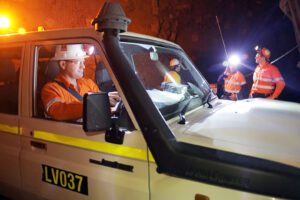Transport and heavy resource companies are spending more money and time implementing state of the art technology and innovative safety management systems; improving HR, training, risk management and IR processes; and investing in the latest and most advanced vehicles and machinery. Despite these initiatives, human error and human factors still account for approximately 90% of all incidents across many industries including transport, heavy resource, maritime, aviation, and medical.
Given these prevalent facts, to date the mentality by the mine operators has been to continue to allocate funds for easier to justify tangible outcomes (e.g. $50,000 on a tyre). On the other hand, investing into less concrete, and seemingly harder to substantiate, operator capability (e.g. identifying operators who are more inclined to get distracted and cause a collision) has been approached with far greater hesitation.
In a 2008 study of Queensland mining safety, operator error was identified to be a contributing factor in 95% of all incidents. The key safety critical human factors identified in the research were: attention lapses, memory slips, auto-piloting, lack of planning, application of knowledge, and loss of situational awareness. It would seem that identification and management of human factor deficits is a key target for machinery and vehicle operator safety in mining.
In a 2008 study of Queensland mining safety, operator error was identified to be a contributing factor in 95% of all incidents.
However, given the pervasiveness and criticality of human factor deficiencies, safety programs that diagnose and develop human factors in mining operators are few and far between. This is because such programs require significant expertise to (1) precisely measure human factors associated with safe operations, and (2) design tailored training that directly improves individual’s abilities.
Human errors are an area of great importance to safety practitioners, particularly within complex industrial and transport systems. In such settings human error is known to be the leading factor in a high proportion of accidents and incidents. For example, human error is the source in 70% of incidents occurring in commercial aviation, human error is behind almost half of the train collisions occurring in the UK, within health care in the US it is estimated that between 44,000 and 88,000 people die each year as a result of doctor errors, and on the road, human error is behind 95% of traffic accidents.
Internationally the mining and resources industry has accident rates higher than that of any other industry, and most of these are caused by human error. Specifically, in Queensland mines for the period 2004 – 08, 95% of incident and accidents were associated with human error, in particular failures in situation awareness, attention and procedural responses.
We know that human error is an extremely common phenomenon and people, regardless of skill level and expertise, make errors every day. Forgetting the location of car/house keys, pushing a door when it requires pulling, taking a wrong turn, dialling an incorrect phone number, forgetting to post a letter, are examples of the common, everyday errors that people make, and which generally have a minimal impact that can be quickly recovered. However, when the same type of attention slips, memory lapses or diminished decision making are made in an industrial environment, the consequences tend to be incidents and accidents involving injuries, fatalities or loss in operational performance.
There are numerous definitions of “human error,” but simply it can be defined as “the physical or mental activity or performance of an incorrect or an inappropriate action, or a failure to perform a particular action that leads to either an undesired or unacceptable outcome.”
Systemic models of safety typically involve a multi-level causal chain of factors that precede each safety breach. Organisational factors such as leadership, work environments, social and cultural conditions, work practices and technology can all play a contributing role in incidents and accidents. That said, almost all systems approach to safety concede that humans are fallible, and errors are to be expected. That is, highly able, skilled and diligent individuals still make mistakes, even in the most controlled industrial settings.
The top three operator errors in mining
Unsafe acts, especially ‘errors’ by the operator, still top accident investigation lists in mining. The top three types of operator errors in mining are:
1) Routine errors, which occur without significant conscious thought. These usually occur due to loss of attention, situational awareness, and memory lapses, such as omitting a critical step in a procedure, not responding to a signal or a stop sign, daydreaming, and operating the machine/vehicle on automaticity and not mindfully;
2) Decision errors, which can be rule-based, knowledge-based or problem solving, such as the use of incorrect equipment, misdiagnosing or misapplying a procedure which is further exacerbated by pressure and stress, and ignoring a warning/caution; and
3) Perceptual errors, which occur due to degraded sensory inputs such as misjudging time, distance, and environmental conditions, and failing to hear signals and alarms.
The source of these common errors usually lies within an individuals’ inherent cognitive, attention, perceptual, psychomotor or dispositional makeup. However, despite their significant impact, these human causes of safety breaches do not attract the same level of research interest as other easier to measure systemic factors like leadership, decision making, fatigue or knowledge and skills.
Psychometric testing identifies causes of breaches
Veedre Assessment and Development Centre (here on referred to as Veedre) analysed assessment and ability rehabilitation data from 111 Australian train divers who had a safety breach or an incident over the period dating 2011-2014. The abilities required to operate a train safely (i.e. attention, focus, situational awareness, performance under pressure and decision making) are very similar to those required to operate other machinery and vehicles such as trucks, dozers, diggers and draglines. Thus, this research has applicability and relevance in resources and transport industries.
Veedre’s psychometric testing of train drivers following an incident or accident identifies whether ability deficits tend to be the primary causes of safety breaches. A battery of computer-based tests (assessment was conducted using the Vienna Test System or VTS) was used and if a driver was found to have significant ability deficits (that is, ability scores below internationally recognised professional operator benchmarks) they were required to undertake computer delivered ability training. This training employed a clinical product used with dementia and brain injury patients during rehabilitation (called Cogniplus), which has been retooled as a coaching system for drivers and operators.
The training program consists of 12 – 18 training sessions undertaken at the worksite over a 3 to 4-week period. Each training session is 60 minutes long, comprising of 40 minutes of computer-based adaptive training on the Cogniplus, targeting the trainee’s ability deficits, followed by 20 minutes of behavioural guidance with a performance coach to extend and embed training. The primary mechanism of training is subconscious development of the target ability through repeated and focussed practice of tasks that challenge the limits of that ability. That is, trainees typically do not necessarily learn any conscious strategies to improve their performance, rather they develop and reinforce unconscious habits that do not require them to think about the ability at all. The ability development is accelerated and reinforced during on-the-job duties and tasks by transferring and practicing behavioural and mental strategies learnt during the training program.
On completion of the complete Cogniplus training program, each driver is re-assessed on the VTS to determine the degree of change in the targeted abilities. Comparison of ability scores from the initial diagnostic assessment against the scores post training indicates the degree of improvement, and hence their readiness to return to driving.
Of the 111 train drivers who had safety breeches or incidents, Veedre’s initial VTS assessments indicated that 65 were below safety critical benchmarks on one or more key abilities and they were therefore recommended to undertake Cogniplus ability training. After completing the training program 61 of the 65 train drivers were able to meet or exceed the necessary safety critical benchmarks based on their post-training re-assessment. Many of these were drivers whose scores with respect to attention, focus, situational awareness, performance under pressure or decision making, had improved from the significant deficit range prior to training, into the acceptable safe operating range post training.
Follow-up ability assessments were conducted at the 6 to 12 month point post-training, proving that 57 of the 61 operators had maintained their safe ability levels over this period. The 4 who did not maintain the training improvements undertook a short refresher course and subsequently regained the improvements. None of these drivers are known to have had a safety breach since completing the training.
This program is used with operators and professional drivers in several ways. The VTS is being applied as a recruitment and selection tool to ensure companies only hire operators with abilities in the safe range. For example, Cavel Ridge and Daunia mines locally, as well as all Anglo mines in Africa, use or have used the VTS for operator selection. The VTS is also being used as an investigation tool following safety incidents, to identify whether operator abilities were a contributing factor and if so what interventions are most appropriate. For example, the rail operator Aurizon uses the VTS and Cogniplus in this manner. Finally, the tools can be used as a safety training program with existing workforces, by identifying current operators with ability deficits and remedying these before they lead to serious incidents and safety breaches. This is a proactive application of human factors assessment and development and a new frontier for safety interventions.
Summary – Human factors can be measured
In summary, we know that human factors associated with human error are important causes of most safety breaches and accidents. We also know that standard safety interventions involving things like improved work practices, behavioural training, leadership, rostering or PPE do not eliminate these human factor causes. Veedre’s psychometric testing and training program has demonstrated that the abilities underpinning many human errors can be measured and improved through targeted ability training. We have also shown that these improvements are sustainable over time even without significant conscious awareness and effort by the operators themselves.
It’s ‘safe’ to say that safety critical ability assessment and rehabilitation training are a useful and efficient addition to the safety improvement practices in industrial settings with a large workforce of drivers and heavy machinery operators.
Read more Mining Safety News and Articles













Add Comment